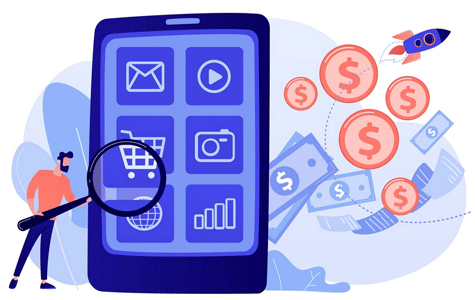The changing economics of consumer spending on technology and entertainment
With streaming costs skyrocketing and inflation at painful levels, there are new methods for keeping monthly charges down or at least stable. Center director Jeffrey Cole explains.
By Jeffrey Cole
The recent wave of inflation has been the most painful since the late 1970s. Rising costs leave many of us looking at our monthly bills for expenses that can be reduced or even eliminated. We can’t do much about housing, food, or transportation (the big expenses) without extreme change like moving or delaying the purchase of a new car.

Credit: Vectorjuice on Freepik
One area where we can make significant changes in our monthly bills is with communication services and devices. In the past, these charges were relatively insignificant. Over the past 15-20 years they have continuously become more costly—to the point where they command an important part of our monthly budgets.
For ten years, the Center for the Digital Future (CDF) has been tracking how much American households spend each month on communication and media services that did not exist a generation or two ago.
In 2013, most of us spent about $246 per month on television (cable, satellite, or the early days of streaming), internet, mobile devices and service, music streaming, DVR charges, and more. Even households at or below the poverty level spent close to $200 per month on these services. Economists wondered where these households found the money and what essential needs were not being met. Mobile phones long ago moved from a novelty or convenience to “life support,” as did broadband.
Ten years later in 2023, the accumulated costs of these services is approaching $350 per month.
The monthly norm for a large majority of American homes is:
- Three mobile phone line charges $110
- Phone hardware charges $60
- Broadband Service $45
- 2.5 streaming subscriptions $33
- Music streaming $9
- Amazon Prime Subscription $11.58
- Cable, satellite, or Streaming TV Packages $70
- Sports or other premium services ++
- Video rentals ++
Total: $338.50++
The start of each month is time for a family discussion about how many of these services “we really need” and what can be cut. Amazon Prime may have felt like a lifeline before COVID, but during the pandemic it became a literal lifeline. There is no going back.
Consumers can’t do much about phone charges except buy new phones less often. Broadband is locked in and indispensable. There is no streaming or useful internet without it.
But, as these charges continue to increase and become substantial parts of our budgets, there are changes many are making to lower or at least stabilize these costs.
In 2013, most of us spent about $246 per month on television (cable, satellite, or the early days of streaming), internet, mobile devices and service, music streaming, DVR charges, and more. Even households at or below the poverty level spent close to $200 per month on these services. Economists wondered where these households found the money and what essential needs were not being met. Mobile phones long ago moved from a novelty or convenience to “life support,” as did broadband. Ten years later in 2023, the accumulated costs of these services is approaching $350 per month.
1. Cutting the cord
At its peak, cable television reached 90% of American households, by far the highest penetration of any country on earth. Cable gave us access to hundreds of channels, but as we got used to them, we only watched about ten. Yet content providers kept creating many new channels so they could bill the carriage fees to the cable company, who passed them along to us.
The recent war between Disney and Spectrum Cable was over the dramatically escalating costs of these cable channels. Disney insisted on increases in their essential channels (ABC and ESPN) as well as increases in channels of little interest to anyone except the studio such as NatGeo Wild, Freeform, FXX, FXM and other channels that had to be paid for if the cable companies wanted the popular ones. Spectrum threatened to leave the television business and eliminate an annual payment of $2.5 billion to Disney if the studio didn’t do something.
Disney lost. We don’t know if Spectrum’s threat was real or a bluff, but they had to get cable costs down. The extra channels went away, and costs stabilized. This was a life-or-death situation for Spectrum because 20,000 households a day are giving up cable. Cable penetration is down to 64% and dropping.
Many subscribers, not just young ones, found they could get the content they wanted through a couple of streaming subscriptions. Most did not see anything on linear television they would miss. For those who did, they could subscribe to new Streaming TV packages such as Hulu TV or YouTube TV that replace cable. However, the evidence is that for every four households that cut the cable cord, only one subscribes to an alternative bundle.
The audience for all the linear channels—including the broadcast networks—is not-so-slowly disappearing.
Cutting the cord without a replacement service is one way that households are saving $70 a month. They are losing many channels, but that does not seem to be a problem.
2. Getting someone else to pay for their streamers
Once Disney+, Apple TV+, Paramount+, Max, and Peacock joined Netflix in the streaming party, subscribers learned they could easily change their streaming lineup on a regular basis. After a signature mini-series finished its seasonal run (Mandalorian, The Last of Us), viewers could unsubscribe until the next season came along.
But a more convenient plan is to get someone else to pay for the streaming subscription. At the moment, I subscribe to six streamers but only “really” pay for one.
The brilliance of Amazon Prime Video is that subscribers feel they get it for free. By the beginning of COVID, Amazon Prime was indispensable for its shipping and other benefits so the video service felt like a bonus. Amazon is in no one’s monthly discussion of what to drop.
I am a T-Mobile customer. For my monthly charges (competitive with the other carriers), I get Netflix and Apple TV+ included at no extra charge. As an American Express Platinum cardholder, I get Wal-Mart+ (their version of Amazon Prime) for free, which gives me Paramount+ at no extra charge. As a Spectrum Cable customer (although for how long?), I get the paid version of Peacock for free. And because Spectrum won their carriage war with Disney, I will soon get Disney+ (with ads) for free.
The only streamer that I pay for is HBO Max. (Sorry Warner Bros. Discovery, I still call it that and will not discard the best quality name in the premium television business; I will never understand why you did.)
While some of these services are themselves expensive (e.g., American Express), most households can find creative ways to get at least one or two streamers for “free” or at reduced costs.
3. Switch to Ad-Supported Streaming
Although the promise of no advertisements was one of the two great appeals of streaming (in addition to no editing of content), the cost of Netflix, Disney+, and others without advertising has become substantial. Netflix just raised its price for ad-free to over $20 while the ad-supported version is $6.99. Disney+ and Hulu (part of Disney) have raised prices twice in the last year.
Just a year or two ago, switching subscriptions to the advertising-supported versions was a way to significantly cut the cost. Now, it only serves to stabilize the price and avoid substantial price hikes.
Most streamers saw that by offering advertising-supported versions at the cost of ad-free only a year ago (Disney+ ad-free premiered in 2019 at $6.99 per month), they could open the flood gates to increased pricing.
These large increases (far outpacing inflation) became necessary as studios realized that they needed to focus on profitability rather than audience growth. It was easy for Disney to grow like a weed at $6.99 per month. But the costs of hugely expensive programming (which just rose because of the settlement of the Writer’s Strike) has required the studios to apply economic discipline to streaming. Some of the streamers (the exception is Netflix) are losing billions of dollars a year.
Streaming was irresistible when subscribers could get mountains of high-quality original content for $7 or $8 per month. It just resulted billions in losses for content providers.
Today, households have turned to ad-supported streaming to keep costs where they are.
The above methods are now a regular part of lowering—or at least containing—monthly streaming costs. Without them, this year’s $348 per month could easily be over $400 in a year or two with no ceiling in sight.
____________

Jeffrey Cole is the founder and director of The Center for the Digital Future at USC Annenberg.
See all columns from the center.
October 25, 2024

